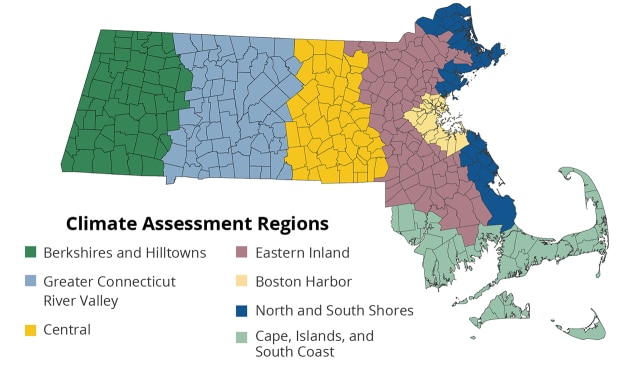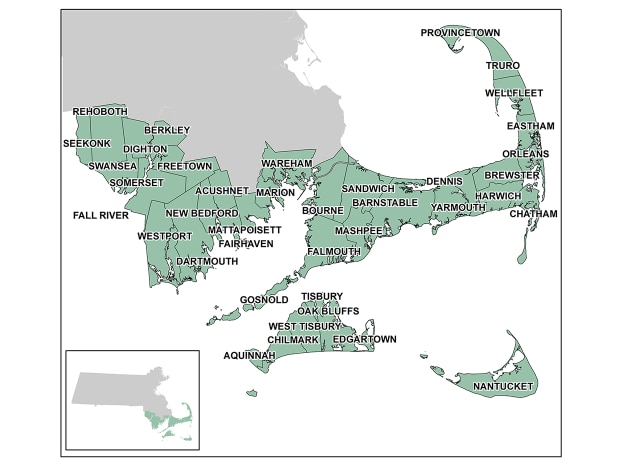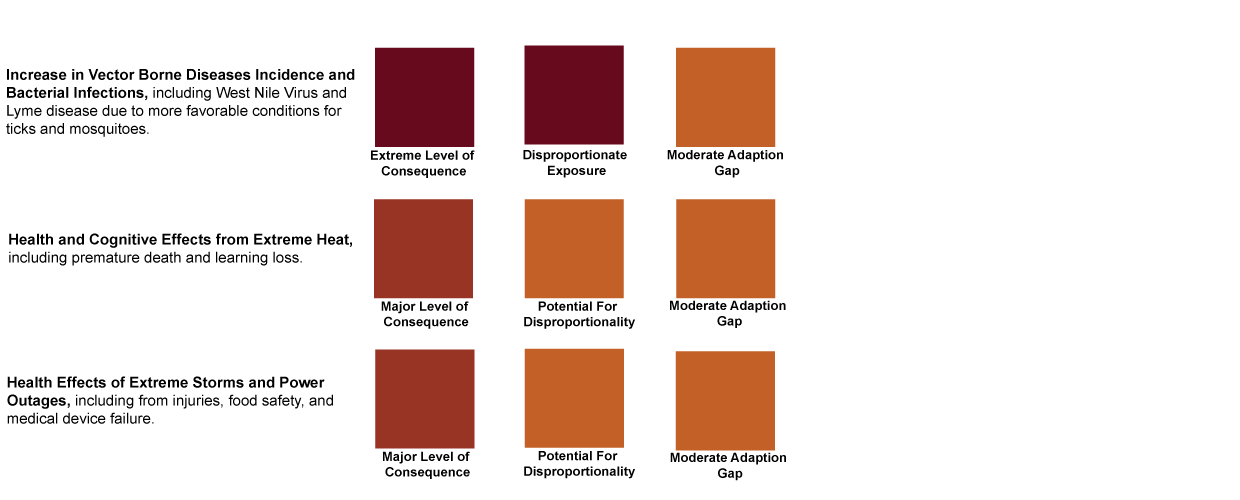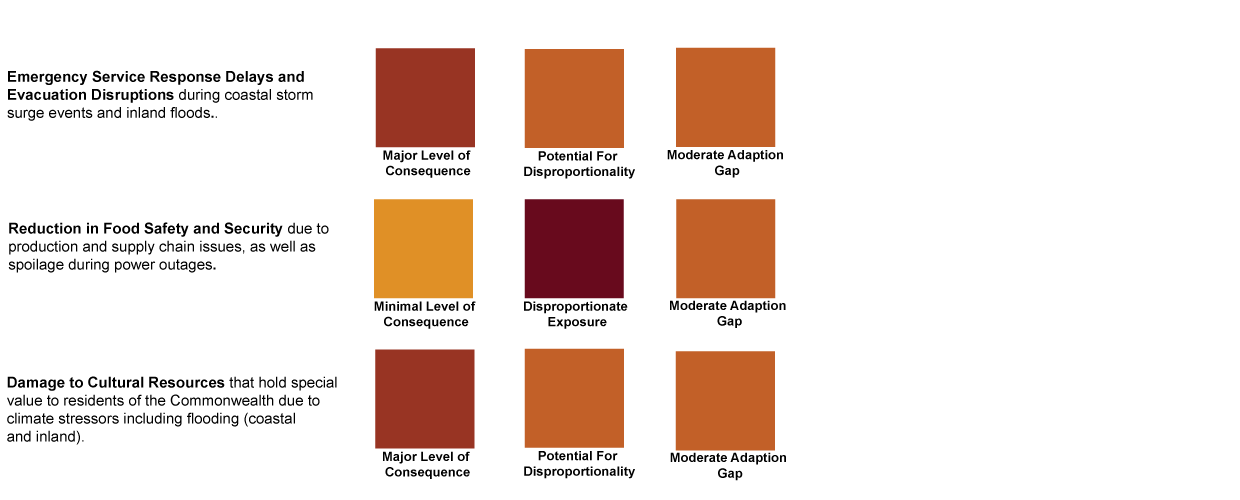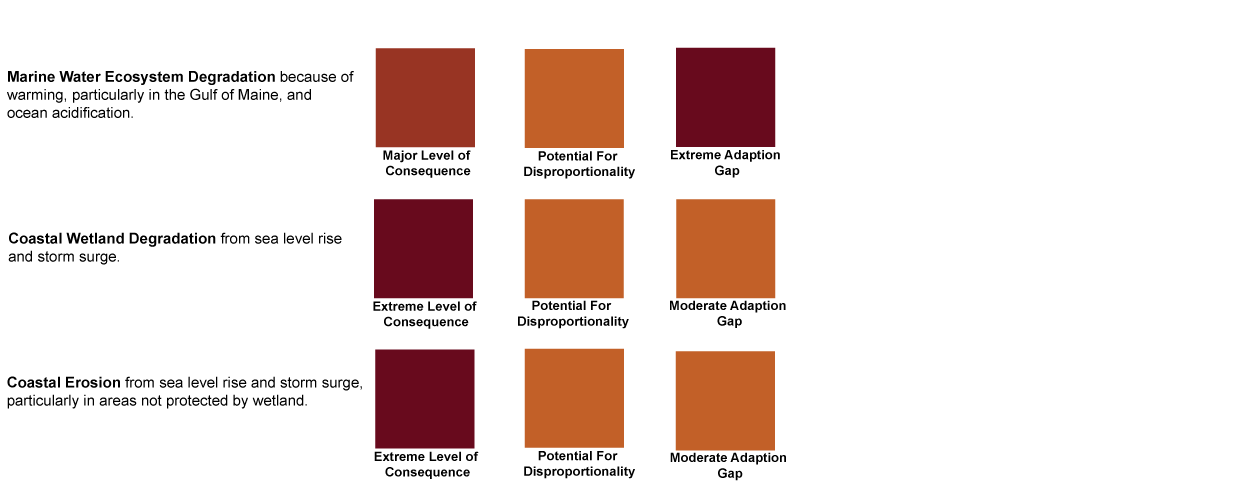Overview
The Commonwealth is already experiencing climate change impacts. Region-specific priorities reflect the unique hazards, natural and built environments, and demographics of each part of the Commonwealth. The Climate Assessment evaluated risks across seven regions:
- Berkshires and Hilltowns Region
- Greater Connecticut River Valley Region
- Central Region
- Eastern Inland Region
- Boston Harbor Region
- North and South Shores Region
- Cape, Islands, and South Coast Region
Volume III of the Climate Assessment includes a summary and full report on each region.
Share These Findings
Share findings about the Cape, Islands, and South Coast region from the MA Climate Change Assessment with your community through the example social media content below:
Regional Context
The Cape, Islands, and South Coast region has the second lowest regional population but features two of the state’s 10 most populous municipalities: New Bedford and Fall River. The region includes nine percent of the state’s environmental justice block groups as designated by EEA, including a disproportionately high share of the low-income block groups (15 percent). The blue economy (meaning economic activity around sustainable ocean resources use) plays a significant role in the region and carries a degree of seasonality, with the service, hospitality, and tourism industries expanding during the summer months. Healthcare, manufacturing, and construction remain steady economic contributors throughout the year. The Cape, Islands, and South Coast have significantly more coastline than any other region. The region’s key natural resources, including 150 miles of marine beach and more than twenty-two thousand acres of coastal wetlands, play a significant role in protecting coastal infrastructure and stimulating the regional economy.
The region boundary used for this assessment encompasses the Office of Coastal Zone Management’s Cape and Islands and South Coast regions. The boundary includes the coastal areas of the Municipal Vulnerability Preparedness (MVP) program’s Southeast region. All 39 of the region’s municipalities are engaged in climate adaptation and resilience planning and action through the MVP grant program.
The most important climate risks for this region include increased coastal hazards, including sea surface temperature changes, coastal flooding, and the potential for hurricane force winds; and flooding associated with high rainfall events. Coastal hazards can affect built infrastructure, marine fisheries productivity, emergency service response times and evacuation routes, and the incidence of injuries.
Most Urgent Impacts - Human Sector
The Increase in Vector Borne Diseases Incidence and Bacterial Infection, though not a high priority statewide, is the most urgent impact in the Cape, Islands, and South Coast region. Currently, approximately 460 cases of Lyme Disease are reported annually in this region. One hundred and seventy additional annual cases of Lyme disease are projected to occur in the region in the near term (2030), with approximately 1,500 additional cases attributable to climate change by 2090.
The next five impacts are tied in terms of urgency score. Cognitive Effects from Extreme Heat is a priority impact both statewide and in the Cape, Islands, and South Coast region. Areas such as Fall River, Hyannis, and Provincetown currently experience some of the hottest temperatures in the Commonwealth. Coastal storms and flooding pose risks to evacuation routes, cultural sites, and electricity distribution systems, all of which can result in damages to people’s health and wellbeing.
*Due to tied scores in the urgency rankings, the Human sector has six most urgent impacts for this region.
Read more about human sector impacts in the report.
Most Urgent Impacts - Infrastructure Sector
Damage to Electric Transmission and Utility Distribution Infrastructure, from stressors such as extreme temperature, extreme rain, lightning, vegetation growth, wildfire activity, and coastal flooding in this region are considered major. Indirect impacts of power outages are addressed as part of other impact categories under the Human (health effects of power outages) and Economy (business interruption) sectors. Reduction in Clean Water Supply is an urgent impact in this region, as much of the region relies on groundwater, as opposed to surface water, which can be more difficult to monitor for shortages. Climate change is projected to lead to reduced groundwater recharge through less infiltration (i.e., precipitation during high volume events cannot absorb in the ground as well as more frequent, lower volume events) and increased temperatures lead to more evaporation. This could lead to periods of stress in the aquifers, though it may also shift timing of aquifer recharge throughout the year rather than a true net decrease in recharge.
Read more about infrastructure sector impacts in the report.
Most Urgent Impacts - Natural Environment Sector
Marine and coastal natural environments are a defining characteristic of the Cape, Islands, and South Coast region. Natural resources are foundational to the identity of the region and support major industries such as fishing and tourism. Marine Ecosystem Degradation is the most urgent impact in this sector. Warming waters, increased ocean acidification, and increased pollution in nearshore areas after extreme precipitation events all lead to a degradation of the marine ecosystem in the region. Coastal Wetland Degradation is another priority concern in the region. The region is projected to experience near term gains in total salt marsh area (with regularly flooded marsh expanding at a faster rate than the projected loss of irregularly flooded marsh), though by the end of the century, the rate of irregularly flooded marsh loss accelerates, resulting in a net loss of about 23 percent of saltmarsh in the region by 2070 and 64 percent by 2100. The shoreline is also affected by Coastal Erosion. High rates of erosion pose a risk to the natural resources, including the loss of the beaches themselves, but also poses a significant threat to salt marsh habitat, and residential areas located immediately landward of the shoreline.
*Due to tied scores in the urgency rankings, the Natural Environment sector has three most urgent impacts for this region.
Read more about natural environment sector impacts in the report.
Most Urgent Impacts - Governance Sector
State and municipal revenues could be reduced with climate change, primarily through decreases in property values and therefore property tax revenue, but also tax losses associated with business interruptions and industry disruptions (e.g., tourism and fisheries). Projected property tax revenue losses statewide top $100 million by mid-century, and although figures are not available specifically for the Cape, Islands, and South Coast region, the region could experience a significant portion of those losses given its exposure to coastal hazards. This region also generates the most local taxes per capita from tourism of any region in the Commonwealth; impacts to the industry could significantly reduce local government revenues. At the same time, demand for government services could grow in response to increased needs for MassHealth, food security support, and emergency response as a result of climate change. Many of these impacts can be expected to be concentrated among those residing in low-income block groups.
Most Urgent Impacts - Economy Sector
The current need for affordably priced housing in the Cape, Islands, and South Coast region is strained particularly because of the need to house seasonal workers in the tourism and hospitality sector, amidst rapidly rising housing prices in the region. New Bedford was the top port in the U.S. by value of seafood landed in 2020, driven by landings of sea scallops, lobsters, and other high value commercial species. With annual landings of approximately $650 million, marine fisheries are a significant driver of the economy in this region and in the state as a whole. Rising water temperatures and ocean acidification associated with climate change have been associated with decreased commercial harvests because of geographic shifts in species distributions poleward, altered seasonality of the fishing season, and changes to stock productivity, especially at middle and lower latitudes.
Featured Adaptation Effort
Coonamesset Bog Restoration
The Town of Falmouth removed a small dam, replaced an under-sized culvert, and restored a former cranberry bog to natural wetland and riverine habitat. This restoration led to increased native species, reduced invasives and a revived herring population.
Quick links
- ResilientMass Homepage
- ResilientMass Site Map
- Massachusetts Climate Change Assessment
- Massachusetts Climate Change Assessment – Berkshires and Hilltowns Region
- Massachusetts Climate Change Assessment – Greater Connecticut River Valley Region
- Massachusetts Climate Change Assessment – Central Region
- Massachusetts Climate Change Assessment – Eastern Inland Region
- Massachusetts Climate Change Assessment – Boston Harbor Region
- Massachusetts Climate Change Assessment – North and South Shores Region
- Massachusetts Climate Change Assessment – Regional Summary Volume III
- Massachusetts Climate Change Assessment – Regional Report Volume III
